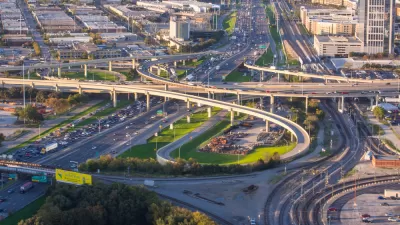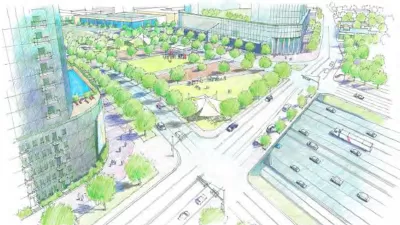Advocates presented a compelling case to remove the aging stretch of Interstate 345 that bisects Dallas adjacent to downtown. But state transportation officials have decided to rehab, rather than remove, the freeway.
The Texas Department of Transportation (TxDOT) has taken a final stand on its plans to rehab I-345 along a 1.7 mile stretch in downtown Dallas. The target for completion of the project, according to an article by Robert Wilonsky, is 2020.
The decision came down to money and traffic. On the former: “TxDOT told the city it will cost $100 million to rehab the bridge, as opposed to the $1 billion it says it would cost to take it down and replace it with, say, a tunnel or some other car-moving option.” And on the latter: “Where do those 170,000 to 200,000 cars per day go?”
The rehab, however, is a band aid solution, allowing the elevated freeway to survive another 20-25 years. In the meantime, proposed park developments wait until the I-345 project is complete and a vision that starts with tearing down the freeway will have to wait.
FULL STORY: TxDOT tells Dallas it will repair and not remove the highway separating Deep Ellum and downtown

Trump Administration Could Effectively End Housing Voucher Program
Federal officials are eyeing major cuts to the Section 8 program that helps millions of low-income households pay rent.

Planetizen Federal Action Tracker
A weekly monitor of how Trump’s orders and actions are impacting planners and planning in America.

Ken Jennings Launches Transit Web Series
The Jeopardy champ wants you to ride public transit.

Crime Continues to Drop on Philly, San Francisco Transit Systems
SEPTA and BART both saw significant declines in violent crime in the first quarter of 2025.

How South LA Green Spaces Power Community Health and Hope
Green spaces like South L.A. Wetlands Park are helping South Los Angeles residents promote healthy lifestyles, build community, and advocate for improvements that reflect local needs in historically underserved neighborhoods.

Sacramento Plans ‘Quick-Build’ Road Safety Projects
The city wants to accelerate small-scale safety improvements that use low-cost equipment to make an impact at dangerous intersections.
Urban Design for Planners 1: Software Tools
This six-course series explores essential urban design concepts using open source software and equips planners with the tools they need to participate fully in the urban design process.
Planning for Universal Design
Learn the tools for implementing Universal Design in planning regulations.
Heyer Gruel & Associates PA
Ada County Highway District
Institute for Housing and Urban Development Studies (IHS)
City of Grandview
Harvard GSD Executive Education
Toledo-Lucas County Plan Commissions
Salt Lake City
NYU Wagner Graduate School of Public Service





























